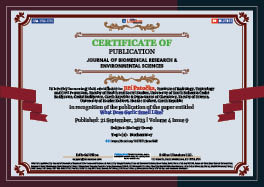Biology Group. 2023 September 21;4(9):1346-1347. doi: 10.37871/jbres1803.
What Does Garlic Smell Like?
Jiří Patočka1,2*, Josef Havel3,4 and Eladia Maria Peña-Méndez5
2Department of Chemistry, Faculty of Science, University of Hradec Králové, Hradec Králové, Czech Republic
3Department of Chemistry, Faculty of Science, Masaryk University, 62500 Brno, Czech Republic
4The International Clinical Research Center of St. Anne's University Hospital Brno, Czech Republic
5Department of Chemistry, Analytical Chemistry Division, Faculty of Chemistry, University of La Laguna, 38204 San Cristóbal de La Laguna, Tenerife, Spain
Garlic (Allium sativum) is an old cultivated plant that has been used by man for millennia for its extraordinary taste and great healing power [1]. The earliest records of the use of garlic come from Egypt. The ancient Egyptians were well aware of its healing properties and ate garlic in large quantities. A Papyrus from 1600 BC depicts a strike by workers working on the construction of the pyramid, protesting that they were not given garlic. The well-known Ebers papyrus, a collection of medical prescriptions 3500 years old, mentions the use of garlic in many diagnoses such as heart weakness, headache, intestinal parasites, eczema, gynecological problems, etc. [2]. The ancient Greeks and Romans also highly valued garlic as a medicinal vegetable. They were convinced that garlic cures coughs and clears the lungs of phlegm and pus. Doctors in China and India consider garlic to be a versatile medicine, treating everything with it: from colds to "aging" [3]. Garlic was first subjected to scientific investigation by Louis Pasteur in the mid-19th century when he studied its bactericidal effects [4]. Since then, garlic has been the subject of constant interest for many researchers.
Garlic has a characteristic pungent smell, which is caused by the content of a number of volatile substances that contain sulfur in their molecule (alliin, allicin, diallyl sulfide, diallyl disulfide, diallyl trisulfide, ajoenes, and others) [5]. These substances have a sharp, irritating smell that spreads long distances [6]. However, many people appreciate garlic not only for its aroma but also for its delicious taste and many positive health effects. The smell of garlic can be powerful and lasts a long time, so many people like it, while others may find it unpleasant.
Garlic also contains several organic selenium compounds that are also biologically active and have potentially beneficial effects on health [7]. It is mainly selenomethionine and selenocysteine [8]. Selenocysteine is found in trace amounts in some proteins and in the body and plays an important role in antioxidant processes. Selenium is an important element for protecting cells from oxidative stress and supporting the proper functioning of the immune system [9], but the amount of selenium in garlic is relatively small.
Another chalcogen, tellurium, was also found in minute amounts in garlic. This metalloid is often used in industry due to its unique chemical and physical properties [10], but information on its presence and biological activities in plants and animals is very limited. It is expected to be rather toxic. Using HPLC coupled with Inductively Coupled Plasma Mass Spectrometry (ICP-MS) or Electrospray Tandem Mass Spectrometry (ESI-MS-MS), methyltellurocysteine oxide and cysteine S-methyltellurosulfide were detected in garlic [11].
Acknowledgement
This work has been supported by the Project of Grant Agency of Czech Republic Nº GA22-07635S.
References
- Londhe VP, Gavasane AT, Nipate SS, Bandawane DD, Chaudhari PD. Role of garlic (Allium sativum) in various diseases: An overview. Angiogenesis. 2011;12(13):129-134.
- Aboelsoud NH. Herbal medicine in ancient Egypt. Journal of Medicinal Plants Research. 2010;4(2):082-086.
- Malik G, Mahajan V, Dhatt AS, Singh DB, Sharma A, Mir JI, et al. Present status and future prospects of garlic (Allium sativum L.) improvement in India with special reference to long day type. J Pharmacognosy Phytochemistry. 2017;6(5):929-933.
- Khashan AA. Antibacterial activity of garlic extract (Allium sativum) against Staphylococcus aureus in vitro. Global J Bio-Sci Biotechnol. 2014;3(2):346-348.
- Majewski M. Allium sativum: facts and myths regarding human health. Rocz Panstw Zakl Hig. 2014;65(1):1-8. PMID: 24964572.
- Hussein HJ, Hameed IH, Hadi MY. A Review: Anti-microbial, Anti-inflammatory effect and Cardiovascular effects of Garlic: Allium sativum. Res J Pharm Technol. 2017;10(11):4069-4078.
- Izgi B, Gucer S, Jaćimović R. Determination of selenium in garlic (Allium sativum) and onion (Allium cepa) by electro thermal atomic absorption spectrometry. Food Chem. 2006;99(3):630-637.
- Ogra Y, Ishiwata K, Iwashita Y, Suzuki KT. Simultaneous speciation of selenium and sulfur species in selenized odorless garlic (Allium sativum L. Shiro) and shallot (Allium ascalonicum) by HPLC–inductively coupled plasma-(octopole reaction system)-mass spectrometry and electrospray ionization-tandem mass spectrometry. J Chromatography A. 2005;1093(1-2):118-125.
- Ayaz E, Alpsoy HC. Sarimsak (Allium sativum) ve geleneksel tedavide kullanimi [Garlic (Allium sativum) and traditional medicine]. Turkiye Parazitol Derg. 2007;31(2):145-9. Turkish. PMID: 17594659.
- Chygorin E, Pečinka L, Vaňhara P, Novotný K, Krempl I, Havel J. Laser ablation synthesis of tellurium carbides using tellurium with nanodiamond nanocomposite. Rapid Commun Mass Spectrom. 2023 Jun 30;37(12):e9520. doi: 10.1002/rcm.9520. PMID: 37038657.
- Anan Y, Yoshida M, Hasegawa S, Katai R, Tokumoto M, Ouerdane L, Łobiński R, Ogra Y. Speciation and identification of tellurium-containing metabolites in garlic, Allium sativum. Metallomics. 2013;5(9):1215-24.
Content Alerts
SignUp to our
Content alerts.
 This work is licensed under a Creative Commons Attribution 4.0 International License.
This work is licensed under a Creative Commons Attribution 4.0 International License.








